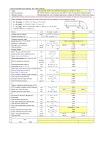In this article we will learn about "TROUBLESHOOTING TIPS FOR ARC WELDING "
| Trouble | Cause | Remedy |
|
Welder runs but soon stops. Welding Arc is loud and spatters excessively. Welding arc is sluggish. Touching the set gives a shock. Generator control fails to vary current. Welder starts but will not deliver welding current. Welder generating but current falls off when welding. Welder will not start (starter not operating). Welder will not start (Starter operating.) Starter operates and blows fuse. |
Wrong relay heaters. Welder is overloaded Duty cycle is too high. Leads are too long or too narrow in cross-section. Power circuit is single-phased. Ambient temperature is too high. Ventilation is blocked. Current setting is too high. Polarity is worng. Current is too low. Poor connections. Cable is too long or too small. Frame not grounded. Any part of field circuit may be short-circuited or open-circuited. Wrong direction of rotation. Brushes are worn or missing. Brush connections are loose. Open field circuit. Series field and armature circuit is open. Wrong driving speed. Dirt on grounding field coils. Welding terminal shorted. Electrode or ground connection loose. Poor Ground. Brushes worn off. Weak brush spring pressure. Brush not properly fitted. Brushes in backwards. Wrong brushes used. Brush pigtails damaged. Rough or dirty commutator. Motor connection single-phased. Power circuit is dead. Broken power lead. Wrong supply voltage. Open power switches. Blown fuses. Overload relay tripped. Open circuit to starter button. Defective operating coil. Mechanical obstruction in contactor. Wrong motor connections. Wrong supply voltage. Rotor struck. Power circuit is single-phased. Starter is single phased. Poor motor connection. Open circuit in windings. Fuse is too small. Short circuit in motor connections. |
See renewal part recommendations. Considerable overload can be carried only for a short time. Do not operate continually at overload currents. Should be large enough to carry welding current without excessive voltage drop. Check for one dead fuse or line. Operate at reduced loads where temperature exceeds 100 F. Check air inlet and exhaust openings. Check setting and output with ammeter. Check polarity ; Try reversing it, or use an electrode of opposite polarity. Check the output and current recommended for the electrode being used. Check all electrode holder, cable, and ground-cable connections. Strap iron is poor. Check cable voltage drop and change cable. Ground it solidly. Find faulty contact and repair it. See " Initial Starting. " Check that all brushes bear on commutator with sufficient tension. Tighten them. Check connection to rheostat, resistor, and auxiliary brush studs. Check it with test lamp or bell ringer. Check nameplate against speed of motor or belt drive. Clean and reinsulate. Electrode holder or cable grounded. Clean and tighten all connections. Check ground return circuit. Replace with recommended grade. Sand to fit. Blow out carbon dust. Replace or readjust brush springs. Sand brushes to fit. Reverse. See renewal part recommendations. Replace brushes. Turn down or clean commutator. Check all connections. Check voltage. Repair. Check nameplate against supply. Close. Replace. Let set cool. Remove cause of overloading. Repair. Replace it. Remove it. Check connection diagram. Check nameplate against supply. Try turning it by hand. Replace fuse ; repair open line. Check contact of starter tips. Tighten it. Repair it. Should be two to three times rated motor current. Check starter and motor leads for insulation from ground and from each other. |













0 Comments